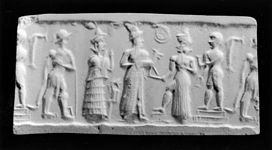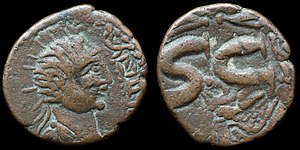Utu
| Utu (Shamash) | |
|---|---|
Sun god God of justice, morality, and truth | |
 Representation of Shamash from the Tablet of Shamash (c. 888 – 855 BC), showing him sitting on his throne dispensing justice while clutching a rod-and-ring symbol | |
| Abode | Heavens |
| Planet | Sun |
| Symbol | Mace, Saw, Sun rays from shoulders, Sun Disk |
| Mount | Sun chariot |
| Personal information | |
| Parents | usually Nanna and Ningal, but sometimes the son of An or Enlil |
| Siblings | Ereshkigal (older sister) and Inanna (twin sister), Ishkur/ Hadad (in some sources) |
| Consort | Sherida |
| Children | Kittu ("Truth") and Misharu ("Justice") |
| Greek equivalent | Helios |
| Roman equivalent | Sol |
| Norse equivalent | Sól |
| Hinduism equivalent | Surya |
Utu,[a] later worshipped by the East Semitic Akkadian-speaking Babylonians as Shamash,[b] was the ancient Mesopotamian sun god, god of justice, morality, and truth, and the twin of the Mesopotamian goddess Inanna (Ishtar in the Assyrio-Babylonian language), the Queen of Heaven. His main temples were in the cities of Sippar and Larsa. He was believed to ride through the heavens in his sun chariot and see all things that happened in the day. He was the enforcer of divine justice and was thought to aid those in distress. According to Sumerian mythology, he helped protect Dumuzid when the galla demons tried to drag him to the Underworld and he appeared to the hero Ziusudra after the Great Flood. In the Epic of Gilgamesh, he helps Gilgamesh defeat the ogre Humbaba.
Family[]

Utu was the twin brother of Inanna,[5][6] the Queen of Heaven, whose domain encompassed a broad variety of different powers.[7][6] In Sumerian texts, Inanna and Utu are shown as extremely close;[8] in fact, their relationship frequently borders on incestuous.[8][9] Utu is usually the son of Nanna, the god of the moon, and his wife, Ningal,[10][11] but is sometimes also described as the son of An or Enlil.[10][11] His wife was the goddess Sherida, later known in Akkadian as Aya.[12][13][11]
Sherida was a goddess of beauty, fertility, and sexual love,[13] possibly because light was seen as inherently beautiful, or because of the sun's role in promoting agricultural fertility.[13] They were believed to have two offspring: the goddess Kittu, whose name means "Truth", and the god Misharu, whose name means "Justice".[13] By the time of the Old Babylonian Period (c. 1830 – c. 1531 BC), Sherida, and consequently Utu, was associated with nadītu, an order of cloistered women who devoted their lives to the gods.[11] Utu's charioteer Bunene is sometimes described as his son.[12][11] Bunene was worshipped independently from Utu as a god of justice in Sippar and Uruk during the Old Babylonian Period[12][11] and he was also worshipped at Assur.[12][11] The dream god Sisig is also described as his son.[14]
Worship[]
Utu was worshipped in Sumer from the very earliest times.[12] The oldest documents mentioning him date to around 3500 BC, during the first stages of Sumerian writing.[11] His main temples, which were both known as E-babbar ("White House"), were located in Sippar and in Larsa.[12] Utu continued to be venerated until the end of Mesopotamian culture[11] and was worshipped for well over 3,000 years.[11] Utu's main personality characteristics are his kindness and generosity,[11] but, like all other Mesopotamian deities, he was not above refusing a request which inconvenienced him.[11] In the Hurro-Akkadian bilingual Weidner god list, Utu is equated with the Hurrian sun-god Šimigi.[15] In the Ugaritic trilingual version of the Weidner god list, Šimigi and Utu are both equated with Lugalbanda.[16]
Iconography[]
In Sumerian texts, Utu is described as "bearded" and "long-armed".[12] In art, he is shown as an old man with a long beard.[11] He was believed to emerge from the doors of Heaven every day at dawn and ride across the sky in his chariot before returning to the "interior of heaven" through a set of doors in the far west every evening.[12] Utu's charioteer was named Bunene.[17] Cylinder seals often show two gods holding the doors open for him as he wields his weapon, the pruning-saw,[12] a double-edged arch-shaped saw with large, jagged teeth, representing his role as the god of justice.[12] Utu's main symbol was the solar disc,[11] a circle with four points in each of the cardinal directions and four wavy, diagonal lines emanating from the circle between each point.[11] This symbol represented the light, warmth, and power of the sun.[11]

Detail of a cylinder seal from Sippar (2300 BC) depicting Shamash with rays rising from his shoulders and holding a saw-toothed knife with which he cuts his way through the mountains of the east at dawn (British Museum)

Old Babylonian cylinder seal impression depicting Shamash surrounded by worshippers (c. 1850-1598 BC)

Mesopotamian limestone cylinder seal and impression showing people worshipping Shamash (Louvre)

Version of the ancient star/Sun symbol of Shamash[18]

Male figure in an Assyrian winged sun emblem (Northwest Palace of Nimrud, 9th century BC; British Museum room B, panel 23). This iconography later gave rise to the Faravahar symbol of Zoroastrianism.

Shamash depicted on bronze coin struck in Hatra (c. 117-138 AD)
Mythology[]
The Sumerians believed that, as he rode through heaven, Utu saw everything that happened in the world.[12][13] Alongside his sister Inanna, Utu was the enforcer of divine justice.[8] At night, Utu was believed to travel through the Underworld as he journeyed to the east in preparation for the sunrise.[13] One Sumerian literary work refers to Utu illuminating the Underworld and dispensing judgement there[19] and Shamash Hymn 31 (BWL 126) states that Utu serves as a judge of the dead in the Underworld alongside the malku, kusu, and the Anunnaki.[19] On his way through the Underworld, Utu was believed to pass through the garden of the sun-god,[13] which contained trees that bore precious gems as fruit.[13]
Utu was believed to take an active role in human affairs,[12] and was thought to aid those in distress.[12] In one of his earliest appearances in literature, in the Myth of Etana, written before the conquest of Sargon of Akkad (c. 2334–2284 BC), the hero Etana invokes Utu to help his wife conceive a child.[11] In the Sumerian poem The Dream of Dumuzid, Utu intervenes to rescue Inanna's husband Dumuzid from the galla demons who are hunting him.[12] In the Sumerian flood myth, Utu emerges after the flood waters begin to subside,[20][21] causing Ziusudra, the hero of the story, to throw open a window on his boat and fall down prostrate before him.[20][21] Ziusudra sacrifices a sheep and an ox to Utu for delivering him to salvation.[20][21]
In the Sumerian King List, one of the early kings of Uruk is described as "the son of Utu"[12] and Utu seems to have served as a special protector to several of that city's later kings.[12] In the Sumerian poem of Gilgamesh and Huwawa, the hero Gilgamesh asks Utu to assist him in his journey to the Cedar Mountain.[22] In this version, Gilgamesh asks Utu's help because Utu is associated with the Cedar Mountain, which is implied to be located in the far east, the land where the sun rises.[23] Utu is initially reluctant to help,[24] but, after Gilgamesh explains that he is doing this because he intends to establish his name, because he knows he will eventually die, Utu agrees.[23] Once Gilgamesh reaches the Cedar Mountain, Utu helps him defeat the ogre Huwawa, who lives there.[24]
In the standard Babylonian Epic of Gilgamesh, Gilgamesh's plan to visit the Cedar Mountain is still his own idea and he goes to Shamash for aid.[25] In this version, however, the Cedar Mountain is explicitly stated to be located in the northwest, in Lebanon.[26] Shamash helps Gilgamesh defeat Humbaba (the East Semitic name for Huwawa).[12][27] Jeffrey H. Tigay suggests that Lugalbanda's association with the sun-god in the Old Babylonian version of the epic strengthened "the impression that at one point in the history of the tradition the sun-god was also invoked as an ancestor".[28] In the Sumerian version, Gilgamesh's initial quest is to visit the Cedar Mountain and Humbaba is merely an obstacle that Gilgamesh and Enkidu encounter once they have already arrived there,[29] but, in the Babylonian version, defeating Humbaba is the initial quest on which the heroes embark.[30] In a late version of the Gilgamesh story, Shamash becomes the instigator of the quest, the one who instructs Gilgamesh to go slay Humbaba to begin with.[30] Tigay describes this as the "final and logical development of [Shamash's] role."[30]
Later influence[]
The authors of the Hebrew Bible generally attempt to portray the sun in a non-anthropomorphic manner, sometimes using it as a symbol of Yahweh's power. The Hebrew word for "sun", šapaš or šemeš, is often substituted for euphemisms, such as the word or, meaning "light". These authors appear to have made a conscious effort to avoid implications of sun worship, even of a Yahwistic variety, at all costs. Specifically, God creates the "greater light," the "lesser light," and the stars. [31]
According to Victor Hamilton, most scholars agree that the choice of "greater light" and "lesser light", rather than the more explicit "Sun" and "Moon", is anti-mythological rhetoric intended to contradict widespread contemporary beliefs that the Sun and the Moon were deities themselves.[32] However, the Woman of the Apocalypse in the Book of Revelation, may directly allude to ancient Near Eastern sun goddesses.[31]
Family tree[]
| An | |||||||||||||||||||||||||||||||||||||||||||||||||||||||||||||||||||
| Ninḫursaĝ | Enki born to Namma | Ninkikurga born to Namma | Nisaba born to Uraš | Ḫaya | |||||||||||||||||||||||||||||||||||||||||||||||||||||||||||||||
| Ninsar | Ninlil | Enlil | |||||||||||||||||||||||||||||||||||||||||||||||||||||||||||||||||
| Ninkurra | Ningal maybe daughter of Enlil | Nanna | Nergal maybe son of Enki | Ninurta maybe born to Ninḫursaĝ | Baba born to Uraš | ||||||||||||||||||||||||||||||||||||||||||||||||||||||||||||||
| Uttu | Inanna possibly also the daughter of Enki, of Enlil, or of An | Dumuzid maybe son of Enki | Utu | Ninkigal married Nergal | |||||||||||||||||||||||||||||||||||||||||||||||||||||||||||||||
| Meškiaĝĝašer | Lugalbanda | Ninsumun | |||||||||||||||||||||||||||||||||||||||||||||||||||||||||||||||||
| Enmerkar | Gilgāmeš | ||||||||||||||||||||||||||||||||||||||||||||||||||||||||||||||||||
| Urnungal | |||||||||||||||||||||||||||||||||||||||||||||||||||||||||||||||||||





